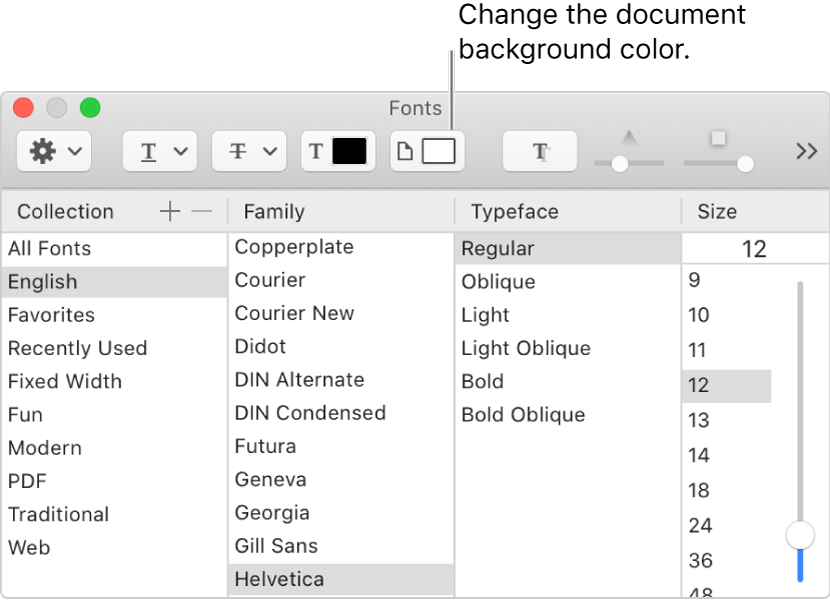
Format with fonts and styles in TextEdit on Mac
You can format text by selecting fonts, font colors, font sizes, and more. You can also format text by applying favorite styles, or styles used in a document.
Note: If you don’t see the toolbar, Choose Format > Make Rich Text.
Change fonts
You can change text font, size, color and other basic formatting using the toolbar buttons.

If your Mac has a Touch Bar, you can use it to quickly format selected text.
You can also do more advanced formatting in the Fonts window.
In the TextEdit app
 on your Mac, choose Format > Font > Show Fonts.
on your Mac, choose Format > Font > Show Fonts.If options for text underlining, color, and more aren’t shown at the top of the Fonts window, click the Action pop-up menu
 , then choose Show Effects. To preview options as you select them, choose Show Preview from the Action pop-up menu.
, then choose Show Effects. To preview options as you select them, choose Show Preview from the Action pop-up menu.Select the text you want to format, then do any of the following:
Change the font: Select a collection, family, or typeface (such as Bold). To search for a font, select All Fonts in the Collection column, then type the font name in the search field. If you don’t see the search field in the Fonts window, make the window wider.
Change the font size: Drag the slider or select a size in the list. If sizes aren’t shown, click the Action pop-up menu, choose Edit Sizes, then select Fixed List, Adjustable Slider, or both.
Change the font color: Click the Text Color button, then select a color in the Colors window.
Underline or strike through text: Click the Text Underline or Text Strikethrough button, then choose an option from the pop-up menu, such as Double. To change the line color, choose Color from the pop-up menu, then click a color.
Insert symbols and characters: Click the Action pop-up menu, choose Characters, then drag a symbol from the Character Viewer into your document.
Set typographic options: Click the Action pop-up menu, then choose Typography. If the selected font includes typography, select or deselect options.
Use Font Book to install and manage fonts on your Mac. To open it from the Fonts window, click the Action pop-up menu, then choose Manage Fonts. See Font Book User Guide.
Change styles
In the TextEdit app ![]() on your Mac, do any of the following:
on your Mac, do any of the following:
Apply a style: Select text, click the Paragraph Styles button
 at the left end of the toolbar, then choose a style. If your Mac has a Touch Bar, you can tap it to apply bold, italic, or underline.
at the left end of the toolbar, then choose a style. If your Mac has a Touch Bar, you can tap it to apply bold, italic, or underline.Reuse a style already in a document: Select the text, choose Format > Font > Copy Style, select the text to reformat, then choose Format > Font > Paste Style.
View all instances of a style in a document: Click the Paragraph Styles button
 in the toolbar, then choose Show Styles. Select Document Styles or Favorite Styles, locate the style you want to find using the controls, and click Select. Then click “Select within entire document” or “Select within existing selection” and click Select.
in the toolbar, then choose Show Styles. Select Document Styles or Favorite Styles, locate the style you want to find using the controls, and click Select. Then click “Select within entire document” or “Select within existing selection” and click Select.Make pasted text match the text around it: Select where to paste the text, then choose Edit > Paste and Match Style.
Save the style of selected text as a favorite: Click the Paragraph Styles button
 in the toolbar, then choose Show Styles. Click Add to Favorites, then type a name. If you want it to use the same font, spacing, and tabs as the selected text, select the checkboxes.
in the toolbar, then choose Show Styles. Click Add to Favorites, then type a name. If you want it to use the same font, spacing, and tabs as the selected text, select the checkboxes.
To format selected text in uppercase, lowercase, or mixed case, choose Edit > Transformations, then choose an option.
Change the background color of your document
In the TextEdit app
 on your Mac, choose Format > Font > Show Fonts.
on your Mac, choose Format > Font > Show Fonts.Alternatively, press Command-T to open the Fonts window.

In the Fonts window, click the Document Background Color button in the toolbar, then select a color in the Colors window.
If you don’t like the background color, click anywhere in the document, choose Edit > Undo Set Document Background Color, then try again.
If you’re using Dark Mode and choose View > Use Dark Background for Windows in TextEdit, some text and background colors may be displayed differently on the screen to ensure the contents of the document are legible.